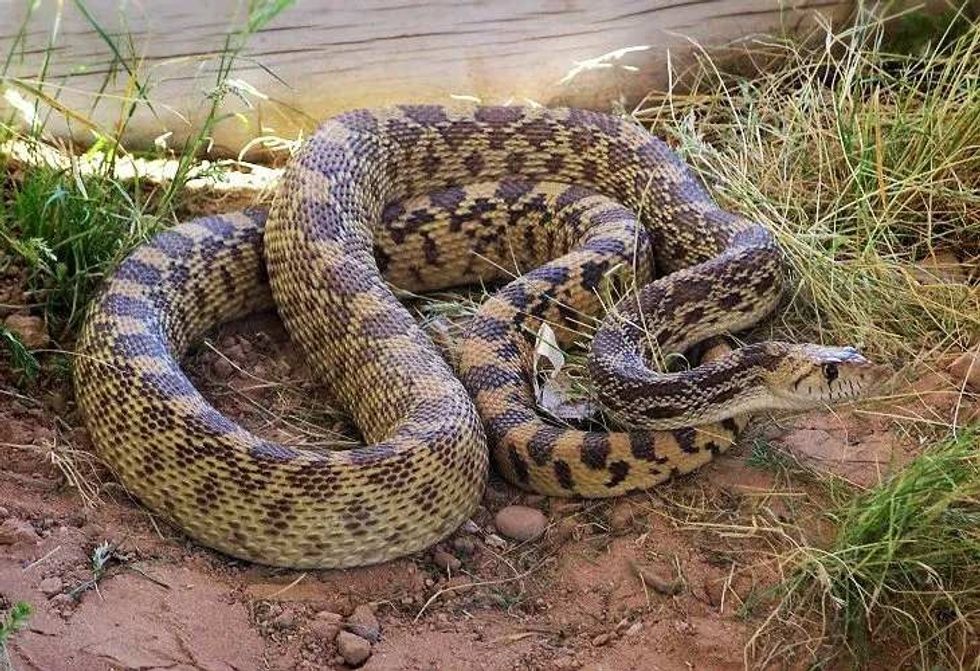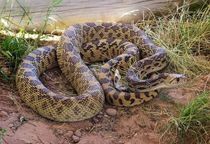Snakes are part of mythology in many cultures, yet they are not well understood and are even feared. In this article, we will learn about the Bullsnake (Pituophis catenifer sayi), which is a large snake that inhabits North America.
These snakes which have a light brown or a yellow body, have a pointed head that is perfect for burrowing through the dirt or loosen the sand in which it lives.
The Bullsnake can be found in many different color variations such as Albino Bullsnake or yellow Bullsnake.
These snakes are often confused with Rattlesnakes, as their appearance and defensive behavior are quite similar in nature. However, when it comes to rattlesnake vs bullsnake, the former is venomous and the latter is not.
Bullsnakes are fascinating creatures, who use their long bodies to constrict their prey instead of venom. This type of snake is endemic to the North-American continent, with their habitat spanning from Northeast Mexico to Texas, all the way up to Canada.
These snakes stay active during the day, but may rest in hot weather to control their body temperature, and even hibernate in the winter months.
Read till the very end of this article to educate yourself on some Bullsnake facts. If you enjoy reading this article about Bullsnakes, then make sure to check out these related articles on rattlesnake and rat snake.
Bullsnake Interesting Facts
What type of animal is a bullsnake?
The Bullsnake is a type of snake.
What class of animal does a bullsnake belong to?
The Bullsnake belongs to the Class Reptilia.
How many bullsnakes are there in the world?
No studies have been done to estimate the size of the bullsnake population.
Where does a bullsnake live?
The Bullsnake lives in old fields, pastures, open forest, and prairies. Bullsnakes prefer to live around sandy-soil places, where rodents that burrow are common. In terms of country borders, bullsnakes are commonly found in the United states and Mexico.
What is a bullsnake's habitat?
Bullsnakes are fossorial, which means that they spend most of their time in burrows. Although, a Bullsnake may be found in open land or climbing trees when they look for prey.
Who do bullsnakes live with?
Bullsnakes are solitary snake species that live and hunt alone. Although, these snakes are known to hibernate with other snakes in winter months.
How long does a bullsnake live?
Bullsnakes have a lifespan of about 12 years, when in the wild. In captivity, they may live as long as 20-30 years.
How do they reproduce?
Bullsnakes are able to reproduce when they are three to four years old. Mating usually takes place in the spring, around March or April, when they come out of hibernation.
Male Bullsnakes are competitive when it comes to mating and can even participate in a ritualized fight with other males. In this fight, the two snakes coil around each other and try to force the opponent's body to go lower into the ground.
The snake that maintains the upper position wins the fight and then might get a chance to mate with the female. No snake gets hurt in the fight.
After mating in early spring, the female lays a clutch of 5-20 eggs during the early summer months.
These leathery round eggs (3.5-4 in long) are often laid in loose soil or sandy burrows that are either dug by the snakes themselves or burrows that have been left empty by small mammals. The incubation period for these eggs is between 64-80 days.
The hatchlings emerge from the eggs in late summer or early fall. These hatchlings remain as a gray bullsnake until they shed their skin and are between 8-18 in long.
What is their conservation status?
In regards to their conservation status, the IUCN lists the Bullsnake as a species of Least Concern. While their population trends seem stable as a whole, with the rapid expansion of urban development practices and agriculture, many local species of the bullsnakes have seen a decline.
In Iowa, the Bullsnake is listed as a species of 'special concern'. The problem of roadkill is a pressing issue for these snakes, as they wander on to roads.
Bullsnake Fun Facts
What do bullsnakes look like?
Bullsnakes, which are considered to be subspecies of Gopher snakes, are relatively large snakes. They have a body with shades of yellow and brown, which has blotches of colors like black, white, or red.
The Bullsnake belly is pale yellow in color and has many square or rectangular dark spots. They do look somewhat similar to the rattlesnake, but the Bullsnake is generally smaller in diameter and does not have any venom. The Bullsnake teeth are used for defending themselves as well as for securing food.
Bullsnake is built with a heavy body that contrasts its smaller head. It also has a shielded nose that protects it when digging.
How cute are they?
The Bullsnake species are not cute, as they look intimidating and scary. They are not as scary in actuality, as these snakes do not have any venom to attack with.
How do they communicate?
A lot of the communication from a bullsnake is performative to ward off threats. A Bullsnake often assumes an S-shaped position to pretend that it will strike. They also use their tails, which vibrate in contact with leaves. These snakes even make a rattling sound from their mouth as they exhale. They hiss loudly as a defense mechanism, too.
How big is a bullsnake?
The Bullsnake (Pituophis catenifer sayi) is one of the largest species of snakes in North America. An average adult Bullsnake can range between 4-6 ft (120-183 cm). These snakes are perhaps the largest subspecies of the gopher snakes. Despite this, the indigo snakes are longer and the rattlesnakes are heavier.
How fast can a bullsnake move?
Bullsnakes are long, agile snakes. They use their discreet and quick movement to be able to catch their prey, which may be small mammals like mice, rats, ground squirrels, and even ground-nesting birds and lizards.
How much does a bullsnake weigh?
Bullsnakes on average weigh between 2.2-3.3 lb (1-1.5 kg).
What are their male and female names of the species?
There are no separate names for male and female species of bullsnakes.
What would you call a baby bullsnake?
A bullsnake baby can be referred to as a juvenile bullsnake.
What do they eat?
Bullsnakes are constrictors, meaning they coil around their prey and asphyxiate it. Smaller mammals and rodents such as moles, rats, gophers, mice, ground squirrels constitute the majority of their diet.
Apart from the rodents, these snakes also prey on frogs, ground-nesting birds, and even birds' eggs. Juvenile bullsnakes prey on smaller lizards, baby mice, and frogs, for their diet. Since these snakes are non-venomous, constricting their prey helps them in immobilizing them.
Are they aggressive?
Bullsnakes are not unreasonably aggressive. This means that if you don't provoke them or startle them, they won't bite you. In any case, the bullsnake bite is non-venomous in nature, which makes them relatively harmless to humans.
Would they make a good pet?
Bullsnakes species can make good pets. At times, they may have a belligerent attitude that may not be ideal for a new pet owner, but Bullsnake care is not that difficult for experienced snake owners.
Each Bullsnake has its own temperament, so your pet may be very timid and even be friendly, others' may be defensive and may hiss loudly in your presence.
These snakes can grow from being 14 in hatchlings to 6 ft, in just 2 years, and thus getting a tank that big enough is crucial for your bullsnake pet. These snakes are generally more active during the day and are also great climbers.
Commercial hides or a cork bar must be provided in the tank. However, ensure that any of the furniture inside the tank doesn't topple over and end up hurting your pet.
The most important thing, however, is to ensure that you get a tank that has a secure lock so that the snake cannot escape.
When it comes to feeding your pet, it is best to serve them pre-killed prey. Just ensure that the meal you plan on feeding to your snake doesn't exceed the diameter of your snake's head by a great margin.
The price of a Bullsnake starts at $200 and can vary according to its size and color. The Kingsville Red Bullsnake costs approximately $250.
Did you know...
Bullsnakes are known to kill rattlesnakes, which is a reason some prefer to leave these snakes alone in the wild. However, there is not enough evidence to actually support this claim.
Ghost bullsnakes, which are one of the Bullsnake morphs, are caused by a genetic mutation that alters the levels of the pigment melanin in their bodies. Notably, this trait is recessive.
Male and female bullsnakes could be identified with their longer and thicker tails. Also, the subcaudal scale could help to figure out the sex of the snake.
When Bullsnakes feel threatened, they puff up their bodies, flatten their head, and coil up.
Why is it called a bullsnake?
Bullsnakes are named after their wrongful reputation as aggressive snakes, which some people call 'bullish'. The name of the subspecies, 'sayi', is named after the renowned American Naturalist, Thomas Say.
What do bullsnakes do in the winter?
During winter months, the bullsnake, much like many other reptiles, hibernates in caves and burrows with other snakes. These snakes emerge from their hibernation in the months of April or May, when it gets warmer.
Here at Kidadl, we have carefully created lots of interesting family-friendly animal facts for everyone to discover! Learn more about some other reptiles including sea snakes, or gophers.
You can even occupy yourself at home by drawing one on our Bullsnake coloring pages.










